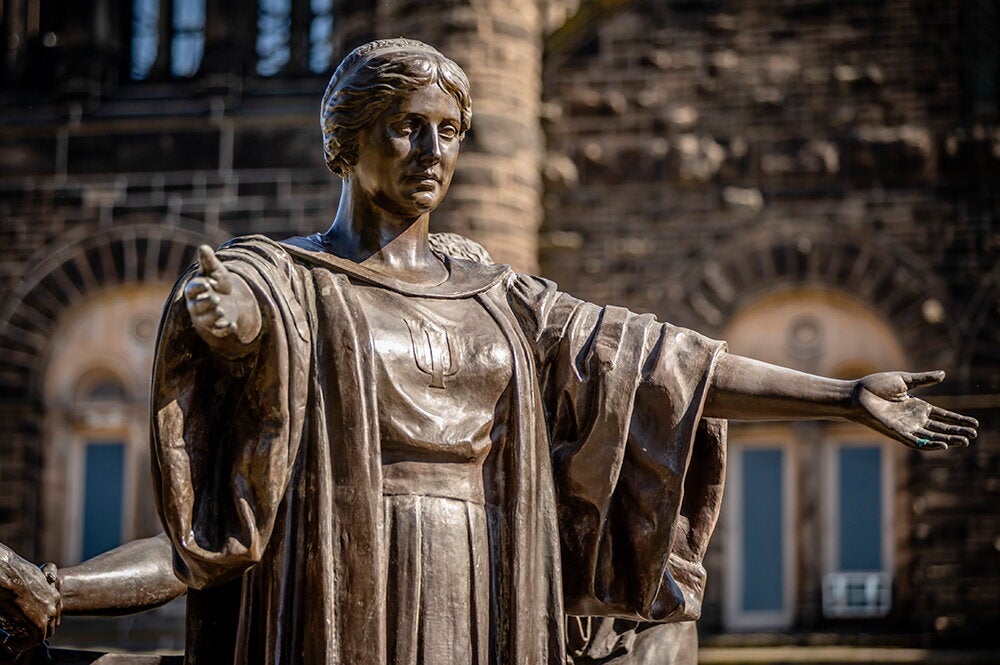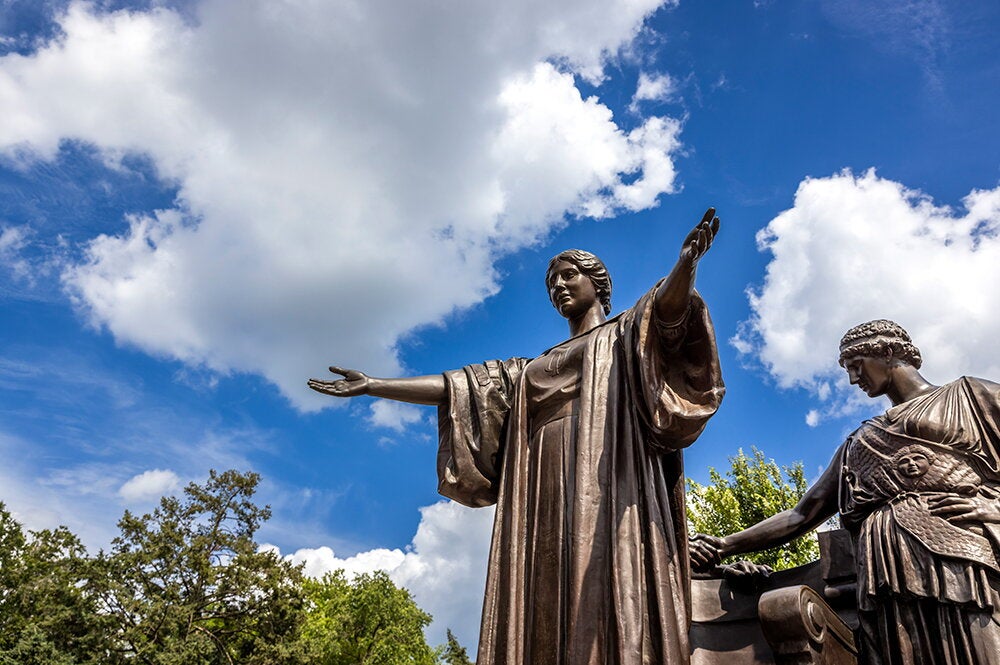
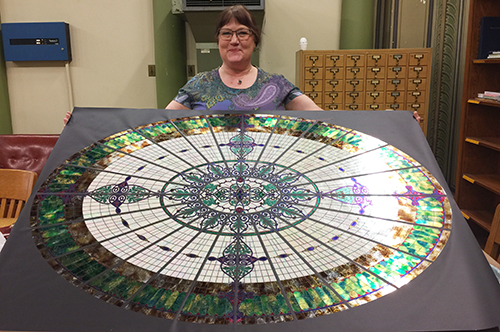
Jane Bergman has always held a special spot in her heart for the brilliance of stained glass.
“My very first memory is being held by my mother (in St. Patrick’s Church in Urbana) while people were singing,” Bergman said. “I was gazing at the enchanting brilliance of the sunlight streaming through the beautiful stained glass windows of the church. That memory still warms my soul.”
That’s why Bergman’s discovery in 2008 that there was once a large, stained glass dome over the library in Altgeld Hall, her very place of work, made such an impact on the university employee.
More than a decade of work later, through countless hours of painstaking research and artistry, Bergman has created a replica of the old dome some 77 years after it was taken down and plastered over.
Altgeld Hall last underwent major renovations in 1956, when the School of Law left and the Department of Mathematics moved in. The dome had been taken down over a decade prior, in 1942.
Bergman, an office manager for the Department of Mathematics, knew that Altgeld Hall was in need of renovation, but a renovation seemed to be a remote possibility in 2008 when she discovered that the dome had once existed. Still, she began work on a replica in hopes that Altgeld Hall would someday be renovated—and that a stained glass dome would be part of it.
Now, with the design firms of CannonDesign and Bailey Edward in the process of planning the renovation, with completion for Altgeld Hall set for 2024, the possibility of restoring or recreating the stained glass dome is, in fact, being investigated, according to building officials.
Long before she was aware of the current renovation plans, however, Bergman wanted to remind people of the beauty of the original work. And so, she set off on her mission to make her own rendition.
Bergman is artsy — she decorated her wedding dress with light blue Swarovski beads, for example, to match her husband’s eyes — and figured that she could learn the skills needed to create something that would allow others to see the beauty that the dome once possessed.
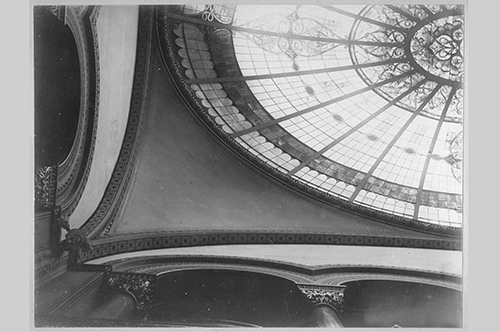
While researching what the old dome looked like, Bergman began taking stained glass courses at Cracked Glass, a stained glass company in Urbana. She quickly worked her way through nearly every class offered.
“I've always had a huge love for stained glass,” Bergman said. “I started working on this and then I realized, 'You know, if I really love stained glass so much, why don't I do it?'”
Creating the rendition proved to be a taller task than Bergman could have foreseen, however. From roughly 2009 to 2011, she spent her lunch hours and much of her free time looking for colored photos of the dome or the original design. It took years of research and work before the two-dimensional, 50-inch by 33.5-inch foil rendition was even imaginable.
“It took me two years to figure out that there wouldn't be a colored picture, so I stopped looking for that,” Bergman said. “I even met with the people over in (the University of Illinois) Archives and looked at old architectural drawings and stuff, hoping that we could find the design.”
She also scoured the Daily Illini and (Champaign-Urbana) News-Gazette archives, to no avail, and couldn’t find an image or sketch of the dome at any local libraries or historical archives. She even examined the university’s Board of Trustee minutes from 1880 to 1900 to find the company that did the design, but found nothing.
Eventually, she found a black and white photo in the University of Illinois Archives that showed about one-quarter of the dome’s design. While excited to have a reference point, Bergman knew it would take extreme attention to detail and some intuitive conclusions to get the design right.
Bergman blew up the photo and traced the lines of the design onto 60-inch by 40-inch poster paper, flipping the copy around in order to fill out the design’s oval shape and adjusting each aspect of the design to mirror the differing panels.
She also examined other stained glass designs in-depth, and, eventually, using skills gained in the courses she was taking, came up with a high-quality drawing. Confident that she had the design as accurate as possible, Bergman scanned it onto a disk and then began working on it in Photoshop.
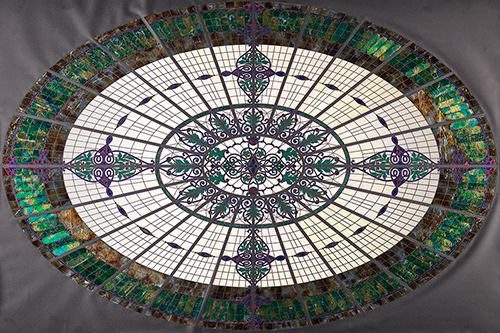
What she thought would be a straightforward process turned out to be anything but. The scan of the design was too detailed and full of imperfections, and the pixels were off-color. So Bergman began to redefine the image, pixel-by-pixel, making thousands of corrections—and restarting after multiple computer crashes—until the image was to her liking.
Once she completed the entire design, she obtained approval to have it printed on foam board and a transparency sheet. Then she began using the foiling skills she had learned, finally beginning to weave the final image of a nearly forgotten masterpiece.
Demonstrating the foiling technique, Bergman said: “I copy the design onto cardstock and onto transparent film. After covering the cardstock with a sheet of double-sided adhesive tape, I cut around each section with an Exacto knife to remove the plastic. Laying the colored foil on the exposed adhesive transfers the foil to the design. Once the foiling is complete, I align the film, with the same design on it, and lay it directly on top. The design on the transparency delineates between the sections, so you can really see the stained glass effect.”
The final product was capped off with the addition of a frame, and it’s now on display in the Mathematics Library in Altgeld Hall in hopes that it inspires support and becomes a precursor for the dome’s return. During all the years she spent on the artwork, Bergman knew that for someone to support a dome, they’d first need to see the full potential of this “beautiful adornment that once graced Altgeld Hall.”
“Upon learning of the original glass dome, I became passionate about replacing it,” Bergman said. “However, that was unlikely to happen without raising awareness of it. My prior experience with the foiling technique prepared me for this task. I just had to create the line design. It was a gift to be at the right place at the right time.”
To learn more about the Campaign for Altgeld and Illini Halls and how to support the project, please visit the project website for more information.
